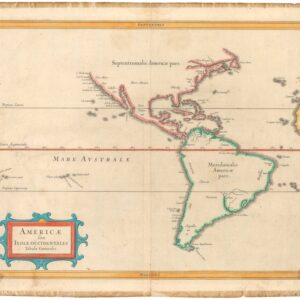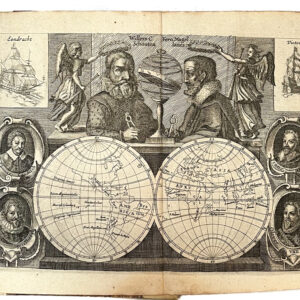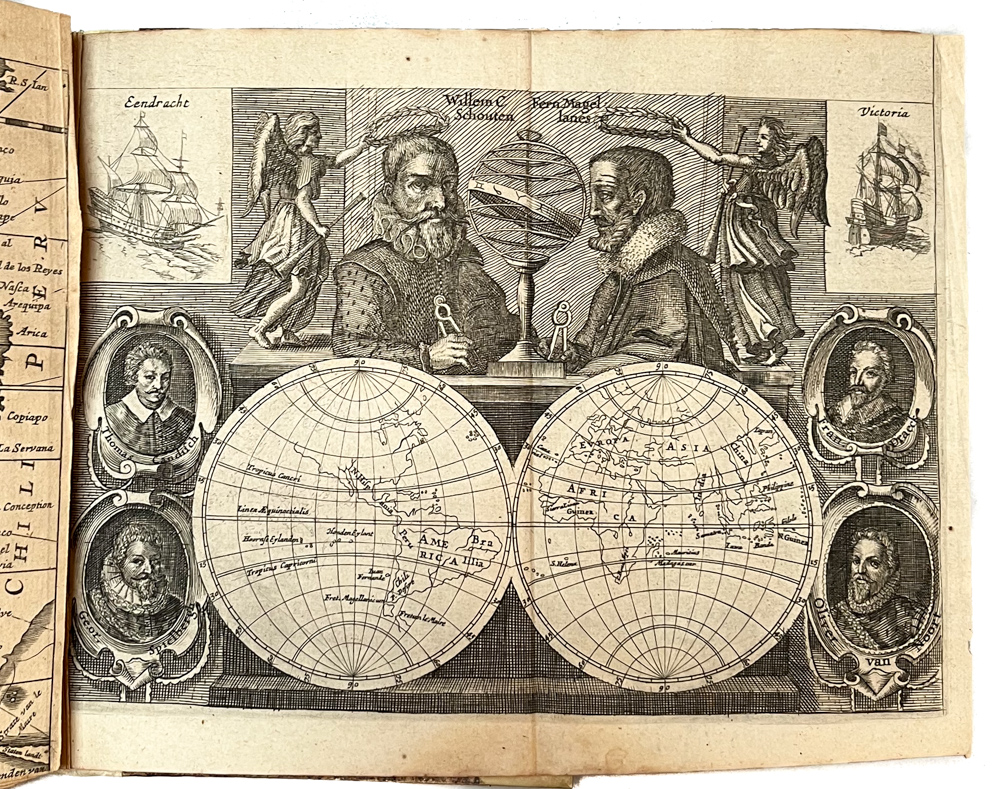Laurent Fries’ Ptolemaic world map from the 1535 Servetus Edition.
Typus Orbis Description Ptolemaei
Out of stock
Description
An elaborate Ptolemaic-style visualization of the ‘Old World’ based on the iconic original by Martin Waldseemüller, perhaps the most important cartographer of the 16th century.
This is the first of three world maps Laurent Fries included in his atlas, Claudi Ptolemaei Geographicae, and constitutes a classic Ptolemaic-style view of the known world. Most maps in Fries’ atlas had been adapted directly from Martin Waldseemüller’s Ptolemaic atlas, which was initially published in 1513 and reissued in 1520. Two of the three world maps Fries included in his atlas were thus built directly on Waldseemüller originals, while the third was one of three new maps that Fries added on his own accord. The reason that the map in question was the first global rendition offered in both Waldseemüller’s and Fries’ atlases was a simple question of chronological perspective. This map represents how the ancients understood the world. This is reflected in the scope of its portrayal, as well as in its constituent elements. For the same reason, much of sub-Saharan Africa and the Far East have not been included simply because Claudius Ptolemy was unfamiliar (though perhaps not entirely unaware) with these places.
Claudius Ptolemy was a Greek mathematician and geographer who, in the second century CE, wrote his Geographia, which constituted a gazetteer of geographical knowledge and the associated coordinates for the entire world, as it was known to the Romans. His work became seminal and was translated into Latin and later into Arabic, but it seems to have been lost to European intelligentsia during the early Middle Ages. The text was preserved and studied in the Islamic world. In the wake of the Crusades, it found its way back into Christendom when Maximus Planudes rediscovered it in the 13th century—the earliest known copies of Ptolemy date to around 1300. By the 15th century, however, it was Europe’s widest-circulated cartographic text and the intellectual basis upon which our geographical understanding rested.
Soon Italian printers began issuing editions of Ptolemy with engraved maps, a tradition which quickly spread throughout Europe (Bologna 1477, Rome 1478, Ulm 1482). Yet their efforts were quickly made obsolete by the Age of Discovery, which provided great cause to reconsider conceptualizations of the world. By the time Waldseemüller and Fries were compiling their maps, the Ptolemaic vision was being transformed, and their atlases were trying to capture this decisive step forward in many ways.
This dynamic is essential, as it saturates the map in question. The printed area is significantly larger than the map itself, surrounded by thick clouds and twelve dramatic wind-heads. Each of the heads represents a specific wind and is labeled as such. The map itself is rendered in a curving style and has a grid of meridians and parallels superimposed on it. Each parallel has been named along the eastern fringe, while grid measurements are provided along the west. The map shows Europe, the northern half of Africa, and most of Asia. It is full of the discrepancies and cartographic myths that one would expect from a Ptolemaic chart from the 16th century, including the Mountains of the Moon (Mons Lunae) in Central Africa and indications of a southward extension of the Chinese mainland.
We should not expect a map like this to aspire toward any observable reality. The blatant discrepancies demonstrate that the intention here was not to show the world as it was understood at the time. Instead, the aim of the map revolved around visualizing a progression of geographical knowledge. On the one hand, it acknowledges the roots of that knowledge, and on the other, it serves as a backdrop upon which the many recent advancements may be underscored. Sri Lanka, for example – here termed Taprobane – is located more or less correctly but constitutes an enormous island that occupies the space where we would expect to find the Indian Subcontinent. This starkly contrasts the seeming omission of Sri Lanka and the inclusion of India in the second world map, which is Fries’ compilation. When juxtaposed, the two maps constitute a ‘before and after’ image demonstrating how far humanity’s understanding of the world has progressed.
Above the map area, we find a strange addition labeled Mare Congelatu and representing the Arctic Sea. A large promontory extends into the frozen sea from the south, apparently as part of continental Eurasia. Transecting all three of the continents shown in the map are mountain ranges. Some of these are recognizable geographical features such as the Alps, Pyrenees, Carpathian, or Ural ranges, whereas others are more difficult to anchor in known physical reality. An extensive range stretches across North Africa, but other than that, this continent sets itself apart by showing its topography with more mountain clusters than ranges. Lakes, rivers, and other waterways have also been schematically included on the map. Most noticeable in this regard is perhaps the exaggerated northern extension of the Black Sea and the disproportional size of the Caspian further east. As was common practice in Ptolemaic maps, toponyms are given in Latin, naming the regions according to their Roman-era conceptualization.
Context is everything
The French cartographer Laurent Fries (Laurentius Frisius), a Rhinelander born in Mulhouse in eastern Burgundy, close to the German and Swiss borders, drew the current map. As a young man, Fries studied medicine and mathematics at the universities of Vienna, Montpellier, Padua, and Colmar before settling in Strasbourg around 1518 to become a physician and medical publisher.
In the following years, he gained employment as a draughtsman working for Peter Apian on his extraordinary heart-shaped map of the world (published in 1520). As part of this work, Fries carefully studied the maps of local master cartographer Martin Waldseemüller, who had published his most seminal world map as early as 1507 and had subsequently complimented this achievement with a significant Ptolemaic-style atlas issued in 1513 (and revised in 1520). Fries’ fascination with Waldseemüller’s maps brought him into contact with the German printer and publisher Johannes Grüninger. This was a significant turning point — for Grüninger was the formal publisher of a group of local scholars known as the St Die Gruppe, which counted prominent members such as Walter Lud, Martin Ringmann, and not least, Martin Waldseemüller.
Strasbourg was famous as a center for cartography at this time, home to two of the world’s best mapmakers: Martin Waldseemüller and Peter Apian. The two set new standards for the compilation of maps and charts, but Waldseemüller, in particular, revolutionized how the world was rendered. Waldseemüller’s hugely influential world map from 1507 would apply the term ‘AMERICA’ for the first time. In an associated text, he explained that the origin of the name pertains to the explorations of Amerigo Vespucci. This was a controversial claim at the time and one that cartographic scholars still debate. The critical thing to note here is that when Waldseemüller issued his version of Claudius Ptolemy’s Geographia in 1513, he changed this label back to ‘Terra Incognita.’ Despite this semi-retraction, the impact of his world map was so profound that the name stuck in perpetuity.
Martin Waldseemüller died in 1520. His death was not only a significant loss to mapmaking but also to local publishing houses and, indeed, to Strasbourg itself, as his output had become an essential source of both income and prestige. Consequently, it was quickly decided to reissue the Waldseemüller atlas in a new edition in the hope that it would sustain interest and income for a time. Grüninger got his hands on the 1520 edition and was keenly interested in filling the gap produced by Waldseemüller’s death. An agreement was reached among several local publishers that a revised and compacted version of Waldseemüller’s monumental tome was in order, and it was Laurent Fries who was hired as the cartographic editor-in-chief for this project. The basis for this decision should probably be sought in his knowledge of Waldseemüller’s work and his close professional association with Peter Apian. Fries started his independent cartographic career by re-drawing Waldseemüller’s famous world map and publishing it in reduced form in Caius Julius Solinus’ Enarrationes, published in Vienna that same year.
Even though Fries was not a geographer by training, he understood many of the mechanisms and skills behind compiling convincing and impacting maps from his time working for Apian. Under Fries’ direction, many of Waldseemüller’s maps were now re-sized and redrawn. While the maps remained essentially unchanged in most respects, Fries would often add text such as historical notes and legends or embolden the map with illustrations of prominent political or mythological figures and a bestiary of both land and sea creatures. Since the aim was to compile a more compact version of the atlas, Fries also introduced the idea of printing text on the verso of the maps and not on separate sheets like Waldseemüller had done. Finally, Fries included three new maps in his atlas, which depicted South-East Asia and the East Indies, China, and the World, respectively. While these were not taken from the 1513 atlas, the geographic information was adapted more or less directly from Waldseemüller’s Universalis Cosmographia, stressing just how seminal he remained even after death.
Chronology of the Fries’ Editions
Fries’ atlas never became the huge commercial success it was intended to be despite having both a more portable format and a more affordable price than Waldseemüller’s original; troubles with distribution and growing competition made sales of the initial edition an uphill battle. There was a widespread idea that the Fries atlas was privileged with better and more up-to-date geographical knowledge. However, this was hardly the case, as Fries built his maps almost exclusively on Waldseemüller’s originals.
Notwithstanding the first edition’s lack of popularity, four distinct and formal editions of the Fries atlas were issued over the next twenty years. The first original atlas was published in Strasbourg in 1522, only two years after Waldseemüller’s death and the publication of the final edition of his Ptolemaic atlas. The first Fries edition consisted of fifty woodcut maps, including one of the earliest known maps to label the New World as ‘America.’ While this was copied directly from Waldseemüller’s Universalis Cosmographia, the tight chronology of these editions and the unavailability of Universalis Cosmographia on the market meant that the Fries editions constitute the earliest acquirable maps to name America. It has been estimated that circa 1000 copies of Waldseemüller’s map 1507 map were issued. Of these, only one known copy survives. This was discovered by Josef Fischer in 1901 in the attic of Wolfegg Castle in southern Germany and was purchased by the Library of Congress a hundred years after.
Despite the ambitions and success of its precursor, Fries’ first edition of the atlas was not a huge commercial success, and the circle of responsible publishers soon felt a need for critical amendments. Thus, a new edition was issued only three years after the initial publication of the atlas (1525). This contained a new text by Wilibald Pirkheimer (adapted from Johannes Regiomontanus) but the same maps as the first version.
In 1531, Grüninger died, and his son carried on his publishing house. Many of the printing plates owned by Grüninger were sold to other publishers to keep the business afloat. The materials for the Fries atlas ended up with two brothers in Lyon, Melchior, and Gaspar Trechsel. They issued a new edition in 1535, with a freshly revised text written by the radical physician and free-thinker Michael Servetus. Consequently, the maps from this publication have become known as the Servetus Edition.
Despite the maps undergoing very little change, this version of the Fries atlas is surrounded by drama. Servetus was tried as a heretic and burned at the stake following its publication. His crime, supposedly, was the following derogatory comments made about the Holy Land in the verso text of the Holy Land map. Roughly translated, it reads:
“And so, most excellent reader, you should realize that in error and by pure exaggeration, a reputation for excellence was bestowed on this land; however, the testimony of merchants and travelers detracted from this inhospitable and barren land, which lacks any attraction, and reputation for excellence. Therefore, this so-called promised land should not be praised in a vernacular language.”
There is no doubt that Servetus was a man of the Enlightenment and, as such, had been a vociferous critic of the religious establishment — particularly of Calvin himself — for decades before being persecuted for this particular crime. Ironically, however, the comments were not part of Servetus’ new text. Instead, they were elements copied from the original Strasbourg editions. Yet Servetus had made powerful enemies and had even managed to escape an arranged Inquisition trial once before. So when Servetus confronted Calvin in person during a sermon in Geneva, he was arrested and imprisoned again.
During his trial, the fact that the comments were not his but adapted from the earlier editions was stressed emphatically but did nothing to sway the prosecutors and judges. On October 27th, 1553, Michael Servetus was burned at stake for blasphemy. He suffered a final denigration in discovering that the pyre upon which he would burn was composed in part of his books, manuscripts, and maps. For this reason, the maps from the Servetus Edition are so rare on the market.
Even though apostasy and descent were generally met with mercilessness from all branches of the Church, Servetus had published extensive critiques of both church and gospel in his youth, eventually landing him such powerful enemies that he was forced to flee to Paris. The fact that he was only caught in the end due to traveling to Geneva to fulminate against his powerful arch-enemy in person shows a degree of fanatic recklessness. Nevertheless, the brutal persecution of a man of knowledge and letters sent shockwaves throughout the cartographic communities of Europe. The 16th century was an age of exploration and experimentation, but new knowledge horizons could not be sought without some backlash. Consequently, when Gaspar Trechsel funded the fourth and final version of Fries’ atlas, published in Vienne in 1541 (i.e. twelve years before Servetus was sentenced to death), the new editor, Dauphiné, made sure that the controversial comments were stricken.
In sum, the trajectory along which 16th-century cartography evolved meant that Waldseemüller, in many ways, remained the great pioneer in mapping the Americas. This was undoubtedly because of his brilliance as a cartographer, but most of all because his Universalis Cosmographia became the chart that ultimately gave America her name. And yet the extraordinary rarity of Waldseemüller’s 1507 map and his decision to remove the America label from the continent in his 1513/1520 atlas meant that the Fries edition of Waldseemüller’s maps constitutes the earliest obtainable copy of a map actually to name America. Among the four Fries editions, in which the maps themselves actually undergo very few changes, the original 1522 and the Servetus editions are the rarest. Moreover, due to the dramatic ‘Enlightenment struggle’ story associated with the third edition, it has also become a symbol of the Enlightenment’s resistance to the Church’s brutal insistence on popular ignorance.
Cartographer(s):
Laurent/Lorenz Fries (ca. 1485-1532) was born in Alsace circa 1490 and studied medicine and mathematics at a number of European universities. He was trained as a physician but was also keenly interested in cartography and medical publications. From 1518-19 Fries is mainly based in Strasbourg, where he was commissioned to compile the first edition of Waldseemüller’s atlas after his death in 1520.
Condition Description
Wear along the centerfold and occasional spotting elsewhere, otherwise clean.
References




![[World] Continentem Dudum Notam Componebat & Continentem Noviter Detectam Componebat.](https://neatlinemaps.com/wp-content/uploads/2024/04/NL-01969-composite_thumbnail-300x300.jpg)